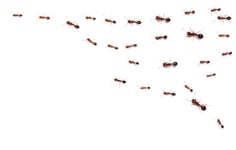
Ant colonies have a complex social structure that is divided into different castes. The queen is typically the largest ant in the colony and her primary role is to reproduce. She is responsible for laying eggs and maintaining the population of the colony. Depending on the species, the worker caste may contain ants of various size which perform tasks such as foraging for food, caring for the brood, protecting the colony, and maintaining the nest.
The social structure of ant colonies is highly organized and depends on effective communication within the nest to function. Each ant has a specific role to play, and they use chemical signals called pheromones to communicate, coordinate, and execute their tasks and activities. Understanding the fascinating social structure of ant colonies can provide valuable insights into the biology and behavior of these tiny yet mighty creatures.
Ants have a significant impact on the environments where they live. They are considered ecosystem engineers because of their nest building, tunneling, and foraging activities that modify, aerate, and enrich the soil. Ants also disperse seeds and contribute to the process of pollination. Some ants even have a symbiotic relationship with plants, offering them protection from plant herbivores and in return, the plants provide food and shelter for the ants.
Additionally, ants are important decomposers. They feed on and break down organic matter, helping with nutrient recycling and maintaining the overall health of the ecosystem. Additionally, ants are known to control the population of other insects by preying on them or competing with them for resources. Their presence in these environments is crucial for maintaining ecosystem balance and function.
There are several common household ant species that a PMP may receive calls for. They include carpenter ants, odorous house ants, pharaoh ants, and pavement ants.
The biology, preferences, and behavior of each ant species is unique. Carpenter ants, for example, are known to cause structural damage and are among some of the largest of the ants encountered by PMPs. They also affect the pest management industry in a big way since they are considered the top generator of income as well as callbacks among the ant pests.
To identify ant nests and trails on your customer’s property, it is important to search for ant activity, observe their behavior, and follow their movements. Ants commonly establish their nests in hidden or secluded areas. Indoor nests have been found in wall voids, under floorboards, and tucked in cracks and crevices. Look for signs of ant activity, which can include small piles of dirt or wood shavings, discarded ant wings, and ant trails.
Ant trails are pathways marked with pheromones that ants use to travel between their nests and their food sources. By following the ant trails, you can locate their nests and implement an effective treatment.
When it comes to ant management, it is important to use effective and economical treatment methods. Start by inspecting for and addressing the ant entry points around the structure. Talk with your customers about the sanitation concerns that are attracting ants indoors and remove those food and water sources that invite ant activity.
Using a non-repellent, transferable product such as FUSE is a highly effective choice for residual control of ants. FUSE is a proprietary product powered by Combination Chemistry®. With a flexible label that allows up to 8 applications per year, FUSE is an excellent choice for exterior perimeter treatments in your ant management service.
PCO Technical Services Manager
